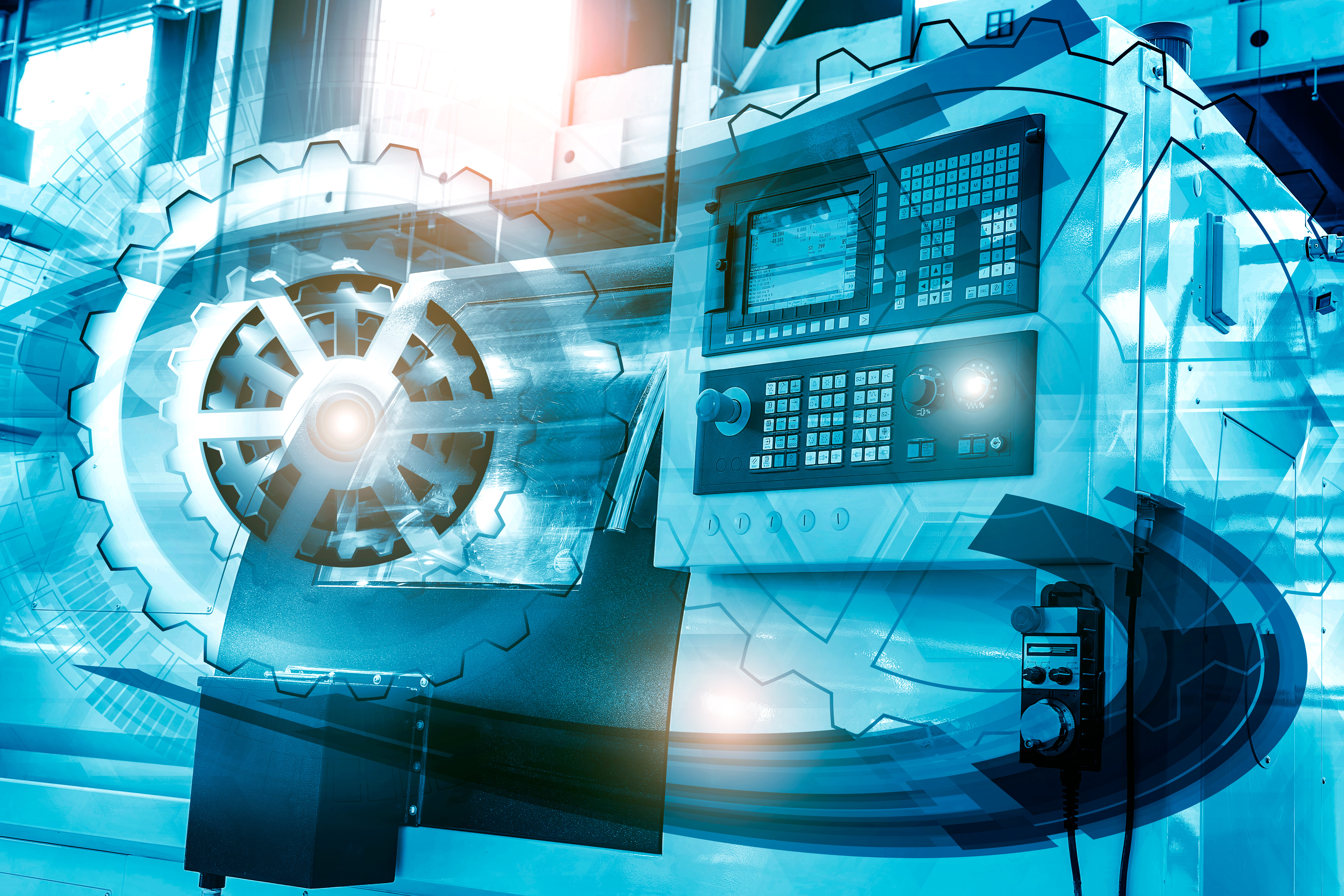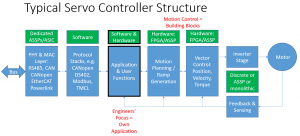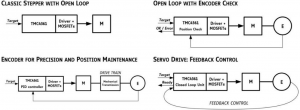Even though it can seem sometimes as if everything is going digital, physical control of the real world isn’t going away anytime soon. The trend toward automating all aspects of the human environment has resulted in an explosion in the deployment of motion controlled systems. Motion control plays a major role in connecting the physical and digital worlds, by translating digital data into physical motion. As automation and robotics spread into consumer as well as industrial applications, motion control and motor drives are moving into areas where they’ve never been needed before, and small electric motors have become ubiquitous.
Product developers must deal with increasingly complex systems, and can no longer be experts in all of the specialized engineering fields required for building its subsystems. Motion control is one of those key specialist areas of knowledge. Yet knowing the right questions to ask before selecting a device for implementing motion control in a design is not always intuitive. We use 3D printing/digital desktop manufacturing as a real-world example of how motion control impacts an application.
What is Motion Control?
Motion control is the part of automation that handles the kinematics and the electromechanical portion of machines in a deliberate and controlled manner. The primary components of a motion control system are the controller and the power amplifier, or driver stage. Typical motion control tasks include velocity ramp/motion profile-generation, micro-stepping, and closed-loop operation.
But today, motion control means more than merely motor control: it also means motion planning for more than one axis, or deciding all of the discrete movements that determine how objects will move in multiple dimensions over time. For several reasons, motion control is no longer just a checklist item in a design. One is because the algorithms used for implementing it have changed, and are also becoming more complex.
As the level of automation continues to rise, another change is the dramatic increase in the number of electric motors used in more and more applications and different operating environments, and increases in requirements regarding dynamics, low noise emissions, and energy efficiency. At the same time, these motors are becoming smaller, more powerful, and more efficient, while expectations about the quality of motion control functions are rising.
Today, overall processing tasks have become heavier and more complex than before, for several reasons.
Complex algorithms already existed for motor and motion control, but they could only be used in high-end expensive applications due to the lack of small, powerful microcontrollers. Now these algorithms are going mainstream, and it’s become feasible to use them in small embedded systems. At the same time, due to increasing integration motion control is becoming a secondary processing task. Today, engineers must be focused primarily on their application, so their primary processing tasks are on the application level, for example image recognition, visual computing, encryption/decryption, and artificial intelligence.
More processing complexity also comes from the fact that communication now includes control and feedback channels, as well as low-latency, high-bandwidth, bus-level communications interfaces. Also, the realization of synchronicity, real-time behavior, and fast response times is already mandatory for synchronizing multiple axes.
Another result of these changes is that in many designs motion control has become a building block. The engineer must now consider not just a motor and how fast it spins, but also how it connects to and interacts with all the other building blocks in a real hardware design, as well as from the software point of view: for example sensors, another motorized axis in the same machine or on the same board, or other automated machines connected via different kinds of networks.
Fig. 1 Motion control embedded in a typical servo controller architecture
Implementation Decisions
Today, design engineers developing motion control systems must not only deal with technology-related questions, but also with a long list of commercial challenges and project-related questions that affect their implementation decisions.
To find out if some ranked higher than others, we asked our field application engineers what are the top five motion control design questions, problems, or issues they hear again and again from customers. These are:
- Time-to-market – Requirements are getting tighter every day for the whole development cycle, including prototyping and the other development stages, all the way through testing and production. So, products used for the motion control part of a mechatronic system must be easy to use, easy to understand, and easy to parameterize. Engineers want building block products that can be used right out of the box and provide the necessary tooling, without having to read a 200-page data sheet first. Fast design-in means they can start focusing on their own application faster.
- Miniaturization/Highest Integration – Especially in embedded motion control motors are getting smaller, and so is the available space for some kind of driver stage or embedded electronics. At the same time, what could be done before only in a large microcontroller (MCU) can now be done in small and smart pieces of silicon. Engineers are looking for the most amount of integration, both functionally and physically, and in the smallest possible space. This is true of both silicon and product packaging, as more engineers make use of systems-on-chip (SoCs), and system-in-package (SiP) configurations paired with a small-outline printed-circuit board (PCB).
- Cost Reduction – The pressure on OEMs and their engineers to cut costs is ongoing. This includes part cost in volume manufacturing and total cost of ownership for software, module hardware, and silicon.
- Motion Control Quality – The performance requirements of motor control and motion control applications are increasing, so the overall quality of these designs needs to increase, too. The concept of motion control quality encompasses multiple dimensions that all affect end-product quality, including but not limited to: noise, accuracy, efficiency, dynamic behavior, and precision.
- Interfaces, Not Motors – More and more engineers are unfamiliar with the physics of motion control and motors, or an understanding of mechanical and materials challenges. In startups and small companies, as well as larger ones, there is a whole new generation of software-centric engineers unfamiliar with motors, mechanics, or materials. They want to work with interfaces, not motors. This trend is driving up the required abstraction level in products used for development, which in turn necessitates the building block approach to motion control.
Application Example: Digital Manufacturing (3D Printing & CNC Machines)
Increasing numbers of industrial machines are being miniaturized into desktop devices. Examples range from equipment for making dental inlays and implants that dentists operate in their own practices, to 3D printers on many engineers’ desktops that are now printing end-use parts that can be replicated exactly, as well as prototypes.
As modern desktop manufacturing applications like 3D printing, computer numerical control (CNC) milling, and laser cutting have become more mature and accessible, real-world end-products can now be manufactured directly from design software. CNC milling already enables high quality in small-batch production.
Motion control is an increasingly important contributor to the success of CNC and 3D printing, if these industrial technologies are to successfully cross over from technical enthusiasts to mainstream users. Producing high-quality multi-dimensional shapes requires precise coordination on two, three, or more axes combined with greater speed and precision of manufactured parts It also requires lower noise and vibration. At the same time, these machines must deliver all this for much lower cost.
Motion Control Quality
The concept of motion control quality covers multiple dimensions: noise, precision, accuracy, efficiency, and dynamic behavior. In 3D printing, key considerations are reducing noise, precision of printing mechanisms, accurate synchronization of multiple axes for high speeds, and the utilization of closed-loop motor control and servo control for increasing printing speed and precision.
Stepper motors are often used for precise positioning in applications such as CNC machines and most desktop and “prosumer” 3D printers. Although favored for their high reliability and low cost, their downside has been high noise levels, even at low speeds or at rest. Since printers and desktop devices are often placed on or near the commercial user’s desk, that noise can be disruptive, especially during print jobs that sometimes last many hours.
With modern control processes and careful layout, these motors can operate virtually silently. Up to now, the primary source of noise has been the motors’ suboptimal commutation modes, which lead to vibrations and resonance of the mechanics for positioning print heads and the extruder motor. The best way to reduce acoustic emissions is to reduce resonance and mechanical vibrations by increasing step resolution using smart drivers. Smaller steps, called “microstepping,” smooth motor operations, greatly reducing resonance, and can also increasing printer speed.
Using closed-loop encoder feedback, the actual positions of the motors can be compared with their commanded target position and differences logged. Without closed-loop the part might actually meet the spec precisely but there is no proof, and precision levels can’t be guaranteed.
In addition, encoder feedback can be used for servo control of the motors using field-oriented control (FOC) algorithms. These algorithms typically require some computation effort: feedback and analog sampling, proportional-integral-derivative (PID) control loops, matrix transformations, and pulse-width modulation (PWM) generation. They also have real-time constraints that make them perfect candidates for being implemented in hardware, inside smart drivers or dedicated servo controller ICs. FOC’s benefit is improved motor efficiency as well as step loss prevention.
Closed-loop motor control and servo control can also be used to increase both printing speed and precision of desktop manufacturing.
Fig. 2 Differences in typical stepper motor control architectures
The Future of Motion Control
Motion control in its many aspects has been around for a long time. But what is new now? What will the future bring? We at TRINAMIC Motion Control are convinced that some important, ongoing trends will drastically shape the future of motion control and how it will be, and should be, used.
Motion control will become a building block.
In networked systems and environments, terms like “IoT” or “inputs and outputs” now dominate, and interfaces dominate. Because of this, engineers’ thinking is becoming more software-centric and focused on ready-to-use building blocks and components that come with a defined, or even standardized, interface and API, and can easily be integrated. In such a world, motion control is just one part of a system – often merely a peripheral part because the major part (from an engineering point of view) is the application itself. Therefore, motion control must be usable like any other sub-block with a certain interface and a defined function set.
Integration will increase.
Motion control devices, SoCs, and chips will not only include analog blocks (ADCs, gate drivers, voltage regulators) and digital standard blocks (commutation logic, PWM), but will get smarter and more complex as well. Integrated communication protocol stacks, signal conditioning tasks, on-the-fly motion profile calculation, high-end commutation algorithms, and control loops will make these devices smarter. There will be very tough competition in functional integration and miniaturization, whether we look at single silicon ICs, SoCs, or systems-on-modules (SoMs).
Motion control will become ubiquitous.
The world will become more and more fully automated. Motion control will continue taking over many more applications, tasks, and needs within the personal and industrial environments in an unnoticed way. This will increase requirements on the quality of motion control in terms of safety, reliability, efficiency, accuracy and precision, and finally, yet importantly, noise.
About TRINAMIC Motion Control
TRINAMIC Motion Control develops the world’s most sophisticated technology for motion and motor control applications. Our state-of-the-art ICs, modules, and mechatronic systems enable today’s software engineers to quickly and reliably develop highly precise drives that work efficiently, smoothly, and quietly. Trinamic is headquartered in Hamburg, Germany with a research center in Tallinn, Estonia, and Sales Engineers in both Chicago, IL, USA and Suzhou, China.
www.trinamic.com/motioncontrol









